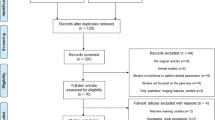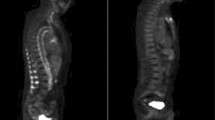Abstract
Objectives
To identify CT markers for screening of early type 2 diabetes and assessment of the risk of incident diabetes using a radiomics method.
Methods
The medical records of 26,947 inpatients were reviewed. A total of 690 patients were selected and allocated to a primary cohort, a validation cohort, and a prediction cohort and used to build prediction models for diabetes. Three radiomics signatures were constructed using CT image features extracted from three regions of interest, i.e., in the pancreas, liver, and psoas major muscle. By incorporating radiomics signatures and other markers, we built a radiomics nomogram that could be used to screen for early diabetes and predict future diabetes.
Results
Of the three abdominal organs for which radiomics signature were constructed, that of the pancreas showed the best discriminatory power for early diabetes screening and prediction (C-statistics of 0.833, 0.846, and 0.899 for the primary cohort, validation cohort, and prediction cohort, respectively). The sensitivity and specificity of the nomogram for prediction of 3-year incident diabetes were 0.827 and 0.807, respectively.
Conclusions
This study presents alternative radiomics markers that have potential for use in screening for undiagnosed type 2 diabetes and prediction of 3-year incident diabetes.
Key Points
• CT images may provide useful information to evaluate the risk of developing diabetes.
• Radiomics score for diabetes prediction is based on subtle changes of abdominal organs detected by CT.
• The radiomics signature of pancreas, a combination of five features of CT images, is efficient for early diabetes screening and prediction of future diabetes (AUC > 0.8).




Similar content being viewed by others
Abbreviations
- AAT:
-
Abdominal adipose tissue
- CI:
-
Confidence interval
- CT:
-
Computed tomography
- LASSO:
-
Least absolute shrinkage and selection operator
- MRI:
-
Magnetic resonance imaging
- ROC:
-
Receiver-operating characteristic
- ROI:
-
Region of interest
- SAT:
-
Subcutaneous adipose tissue
- VAT:
-
Visceral adipose tissue
References
NCD Risk Factor Collaboration (NCD-RisC) (2016) Worldwide trends in diabetes since 1980: a pooled analysis of 751 population-based studies with 4. 4 million participants. Lancet 387:1513–1530
Guo F, Garvey WT (2015) Development of a weighted cardiometabolic disease staging (CMDS) system for the prediction of future diabetes. J Clin Endocrinol Metab 100:3871–3877
Diabetes Prevention Program Research Group, Knowler WC, Fowler SE et al (2009) 10-year follow-up of diabetes incidence and weight loss in the diabetes prevention program outcomes study. Lancet 374:1677–1686
Beagley J, Guariguata L, Weil C, Motala AA (2014) Global estimates of undiagnosed diabetes in adults. Diabetes Res Clin Pract 103:150–160
Fisher-Hoch SP, Vatcheva KP, Rahbar MH, McCormick JB (2015) Undiagnosed diabetes and pre-diabetes in health disparities. PLoS One 10:e0133135
Lee YH, Armstrong EJ, Kim G et al (2015) Undiagnosed diabetes is prevalent in younger adults and associated with a higher risk cardiometabolic profile compared to diagnosed diabetes. Am Heart J 170:760–769 e762
Zhou X, Qiao Q, Ji L et al (2013) Nonlaboratory-based risk assessment algorithm for undiagnosed type 2 diabetes developed on a nation-wide diabetes survey. Diabetes Care 36:3944–3952
Ding D, Chong S, Jalaludin B, Comino E, Bauman AE (2015) Risk factors of incident type 2-diabetes mellitus over a 3-year follow-up: results from a large Australian sample. Diabetes Res Clin Pract 108:306–315
Abbasi A, Sahlqvist AS, Lotta L et al (2016) A systematic review of biomarkers and risk of incident type 2 diabetes: an overview of epidemiological, prediction and aetiological research literature. PLoS One 11:e0163721
Kengne AP, Beulens JW, Peelen LM et al (2014) Non-invasive risk scores for prediction of type 2 diabetes (EPIC-InterAct): a validation of existing models. Lancet Diabetes Endocrinol 2:19–29
Herder C, Kowall B, Tabak AG, Rathmann W (2014) The potential of novel biomarkers to improve risk prediction of type 2 diabetes. Diabetologia 57:16–29
Grundy SM (2012) Pre-diabetes, metabolic syndrome, and cardiovascular risk. J Am Coll Cardiol 59:635–643
Wang A, Chen G, Su Z et al (2016) Risk scores for predicting incidence of type 2 diabetes in the Chinese population: the Kailuan prospective study. Sci Rep 6:26548
Abbasi A, Peelen LM, Corpeleijn E et al (2012) Prediction models for risk of developing type 2 diabetes: systematic literature search and independent external validation study. BMJ 345:e5900
Chiu HK, Tsai EC, Juneja R et al (2007) Equivalent insulin resistance in latent autoimmune diabetes in adults (LADA) and type 2 diabetic patients. Diabetes Res Clin Pract 77:237–244
McTernan CL, McTernan PG, Harte AL, Levick PL, Barnett AH, Kumar S (2002) Resistin, central obesity, and type 2 diabetes. Lancet 359:46–47
Kaess BM, Pedley A, Massaro JM, Murabito J, Hoffmann U, Fox CS (2012) The ratio of visceral to subcutaneous fat, a metric of body fat distribution, is a unique correlate of cardiometabolic risk. Diabetologia 55:2622–2630
Tang L, Zhang F, Tong N (2016) The association of visceral adipose tissue and subcutaneous adipose tissue with metabolic risk factors in a large population of Chinese adults. Clin Endocrinol (Oxf) 85:46–53
Storz C, Heber SD, Rospleszcz S et al (2018) The role of visceral and subcutaneous adipose tissue measurements and their ratio by magnetic resonance imaging in subjects with prediabetes, diabetes and healthy controls from a general population without cardiovascular disease. Br J Radiol. https://doi.org/10.1259/bjr.20170808:20170808
Liu L, Feng J, Zhang G et al (2018) Visceral adipose tissue is more strongly associated with insulin resistance than subcutaneous adipose tissue in Chinese subjects with pre-diabetes. Curr Med Res Opin 34:123–129
Onat A, Uğur M, Can G, Yüksel H, Hergenç G (2010) Visceral adipose tissue and body fat mass: predictive values for and role of gender in cardiometabolic risk among Turks. Nutrition 26:382–389
Shulman GI (2014) Ectopic fat in insulin resistance, dyslipidemia, and cardiometabolic disease. N Engl J Med 371:2237−2238
Wong VW, Wong GL, Yeung DK et al (2014) Fatty pancreas, insulin resistance, and beta-cell function: a population study using fat-water magnetic resonance imaging. Am J Gastroenterol 109:589–597
Tushuizen ME, Bunck MC, Pouwels PJ et al (2007) Pancreatic fat content and beta-cell function in men with and without type 2 diabetes. Diabetes Care 30:2916–2921
Aerts HJ, Velazquez ER, Leijenaar RT et al (2014) Decoding tumour phenotype by noninvasive imaging using a quantitative radiomics approach. Nat Commun 5:4006
Gillies RJ, Kinahan PE, Hricak H (2016) Radiomics: images are more than pictures, they are data. Radiology 278:563–577
Lambin P, Rios-Velazquez E, Leijenaar R et al (2012) Radiomics: extracting more information from medical images using advanced feature analysis. Eur J Cancer 48:441–446
Liu Z, Zhang XY, Shi YJ et al (2017) Radiomics analysis for evaluation of pathological complete response to neoadjuvant chemoradiotherapy in locally advanced rectal cancer. Clin Cancer Res. https://doi.org/10.1158/1078-0432.CCR-17-1038:clincanres.1038.2017
Huang YQ, Liang CH, He L et al (2016) Development and validation of a radiomics nomogram for preoperative prediction of lymph node metastasis in colorectal cancer. J Clin Oncol 34:2157–2164
Kuo MD, Jamshidi N (2014) Behind the numbers: decoding molecular phenotypes with radiogenomics--guiding principles and technical considerations. Radiology 270:320–325
McDonald RJ, McDonald JS, Kallmes DF, Carter RE (2013) Behind the numbers: propensity score analysis-a primer for the diagnostic radiologist. Radiology 269:640–645
Shafiq-Ul-Hassan M, Zhang GG, Latifi K et al (2017) Intrinsic dependencies of CT radiomic features on voxel size and number of gray levels. Med Phys 44:1050–1062
He L, Huang Y, Ma Z, Liang C, Liang C, Liu Z (2016) Effects of contrast-enhancement, reconstruction slice thickness and convolution kernel on the diagnostic performance of radiomics signature in solitary pulmonary nodule. Sci Rep 6:34921
Harrell FE Jr, Lee KL, Mark DB (1996) Multivariable prognostic models: issues in developing models, evaluating assumptions and adequacy, and measuring and reducing errors. Stat Med 15:361–387
Kühn JP, Berthold F, Mayerle J et al (2015) Pancreatic steatosis demonstrated at MR imaging in the general population: clinical relevance. Radiology 276:129–136
Nowotny B, Kahl S, Kluppelholz B et al (2018) Circulating triacylglycerols but not pancreatic fat associate with insulin secretion in healthy humans. Metabolism 81:113–125
Vaag A, Lund SS (2007) Non-obese patients with type 2 diabetes and prediabetic subjects: distinct phenotypes requiring special diabetes treatment and (or) prevention? Appl Physiol Nutr Metab 32:912–920
Perry RJ, Samuel VT, Petersen KF, Shulman GI (2014) The role of hepatic lipids in hepatic insulin resistance and type 2 diabetes. Nature 510:84–91
Awazawa M, Gabel P, Tsaousidou E et al (2017) A microRNA screen reveals that elevated hepatic ectodysplasin A expression contributes to obesity-induced insulin resistance in skeletal muscle. Nat Med 23:1466–1473
Camastra S, Vitali A, Anselmino M et al (2017) Muscle and adipose tissue morphology, insulin sensitivity and beta-cell function in diabetic and nondiabetic obese patients: effects of bariatric surgery. Sci Rep 7:9007
Bril F, Barb D, Portillo-Sanchez P et al (2017) Metabolic and histological implications of intrahepatic triglyceride content in nonalcoholic fatty liver disease. Hepatology 65:1132–1144
Cusi K, Sanyal AJ, Zhang S et al (2017) Non-alcoholic fatty liver disease (NAFLD) prevalence and its metabolic associations in patients with type 1 diabetes and type 2 diabetes. Diabetes Obes Metab 19:1630–1634
Tushuizen ME, Bunck MC, Pouwels PJ, Bontemps S, Mari A, Diamant M (2008) Lack of association of liver fat with model parameters of beta-cell function in men with impaired glucose tolerance and type 2 diabetes. Eur J Endocrinol 159:251–257
Yeoh AJ, Pedley A, Rosenquist KJ, Hoffmann U, Fox CS (2015) The association between subcutaneous fat density and the propensity to store fat viscerally. J Clin Endocrinol Metab 100:E1056–E1064
Acknowledgements
The authors acknowledge the technical assistance of Professor Shou-Hua Luo from the Image and Signal Processing Laboratory at the Southeast University.
Funding
This study has received funding by the National Nature Science Foundation of China (NSFC, No. 81525014), the Jiangsu Provincial Special Program of Medical Science (BL2013029), and the Key Research and Development Program of Jiangsu Province (BE2016782).
Author information
Authors and Affiliations
Corresponding author
Ethics declarations
Guarantor
The scientific guarantor of this publication is Shenghong Ju.
Conflict of interest
The authors declare that they have no conflict of interest.
Statistics and biometry
No complex statistical methods were necessary for this paper.
Informed consent
Written informed consent was waived by the Institutional Review Board.
Ethical approval
Institutional Review Board approval was obtained.
Methodology
• Retrospective
• Diagnostic or prognostic study
• Performed at one institution
Electronic supplementary material
ESM 1
(DOCX 1775 kb)
Rights and permissions
About this article
Cite this article
Lu, CQ., Wang, YC., Meng, XP. et al. Diabetes risk assessment with imaging: a radiomics study of abdominal CT. Eur Radiol 29, 2233–2242 (2019). https://doi.org/10.1007/s00330-018-5865-5
Received:
Revised:
Accepted:
Published:
Issue Date:
DOI: https://doi.org/10.1007/s00330-018-5865-5




